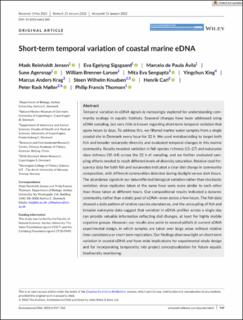| dc.contributor.author | Jensen, Mads Reinholdt | |
| dc.contributor.author | Sigsgaard, Eva Egelyng | |
| dc.contributor.author | Ávila, Marcelo De Paula | |
| dc.contributor.author | Agersnap, Sune | |
| dc.contributor.author | Brenner-Larsen, William | |
| dc.contributor.author | Sengupta, Mita Eva | |
| dc.contributor.author | Xing, Yingchun | |
| dc.contributor.author | Krag, Marcus Anders | |
| dc.contributor.author | Knudsen, Steen Wilhelm | |
| dc.contributor.author | Carl, Henrik | |
| dc.contributor.author | Møller, Peter Daniel Rask | |
| dc.contributor.author | Thomsen, Philip Francis | |
| dc.date.accessioned | 2022-09-09T12:51:34Z | |
| dc.date.available | 2022-09-09T12:51:34Z | |
| dc.date.created | 2022-03-30T10:28:39Z | |
| dc.date.issued | 2022 | |
| dc.identifier.citation | Environmental DNA. 2022, 4 (4), 747-762. | en_US |
| dc.identifier.issn | 2637-4943 | |
| dc.identifier.uri | https://hdl.handle.net/11250/3016926 | |
| dc.description.abstract | Temporal variation in eDNA signals is increasingly explored for understanding community ecology in aquatic habitats. Seasonal changes have been addressed using eDNA sampling, but very little is known regarding short-term temporal variation that spans hours to days. To address this, we filtered marine water samples from a single coastal site in Denmark every hour for 32 h. We used metabarcoding to target both fish and broader eukaryote diversity and evaluated temporal changes in this marine community. Results revealed variation in fish species richness (15–27) and eukaryote class richness (35–64) across the 32 h of sampling, and we further evaluated sampling efforts needed to reach different levels of diversity saturation. Relative read frequency data for both fish and eukaryotes indicated a clear diel change in community composition, with different communities detected during daylight versus dark hours. The abundance signals in our data reflected biological variation rather than stochastic variation, since replicates taken at the same hour were more similar to each other than those taken at different hours. Our compositional results indicated a dynamic community, rather than a static pool of eDNA—even across a few hours. The fish data showed a daily pattern of relative species abundances, and the uncoupling of fish and broader eukaryote data suggest that variation in eDNA profiles across a single day can provide valuable information reflecting diel changes, at least for highly mobile organism groups. However, our results also point to several pitfalls in current eDNA experimental design, in which samples are taken over large areas without relative time-consistency or short-term replication. Our findings shed new light on short-term variation in coastal eDNA and have wide implications for experimental study design and for incorporating temporality into project conceptualization for future aquatic biodiversity monitoring. | en_US |
| dc.language.iso | eng | en_US |
| dc.publisher | Wiley | en_US |
| dc.rights | Navngivelse 4.0 Internasjonal | * |
| dc.rights.uri | http://creativecommons.org/licenses/by/4.0/deed.no | * |
| dc.title | Short-term temporal variation of coastal marine eDNA | en_US |
| dc.type | Peer reviewed | en_US |
| dc.type | Journal article | en_US |
| dc.description.version | publishedVersion | en_US |
| dc.rights.holder | © 2022 The Authors. | en_US |
| dc.source.pagenumber | 747-762 | en_US |
| dc.source.volume | 4 | en_US |
| dc.source.journal | Environmental DNA | en_US |
| dc.source.issue | 4 | en_US |
| dc.identifier.doi | 10.1002/edn3.285 | |
| dc.identifier.cristin | 2013609 | |
| cristin.ispublished | true | |
| cristin.fulltext | original | |
| cristin.qualitycode | 1 | |

